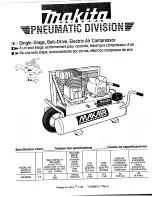
4: Installation
SN55, SN55S, SN55V, SN75, SN75S, SN75V User Manual
02250247-571 R04
55
Subject to EAR, ECCN EAR99 and related export control restrictions.
utilizing an aftercooler. Cooler water will reduce water-
flow requirements and warmer water will increase water-
flow requirements.
Water piping to and from the compressor unit must be a
minimum of 1 inch diameter. Isolation valves with side
drains should be installed on both input and return lines.
Input water should have a 2 mm strainer installed in-line.
A normally closed solenoid valve should be connected to
the water outlet of the compressor. The compressor con-
trol circuit switches this circuit. Consult the Sullair Service
Department for assistance in these setups.
Water quality is critical to proper cooling of the compres-
sor. Excessive build-up of lime, scale or other deposits
can restrict the flow of water to the compressor. These
deposits act as a thermal insulator and reduce the effi-
ciency of the water cooler.
The cleaning of piping and water coolers is the cus-
tomer’s responsibility. Inspect all piping for deposits and
clean as necessary. Refer to
Section 4.2.5: Water quality
recommendations
on page 56.
Table 4-2: Ventilation requirements
indicates the mini-
mum ventilation requirements necessary to keep the
compressor running at its normal operating temperature.
The fan air requirement is the amount of air, which must
flow through the compressor for proper ventilation. The
heat rejection requirement is the amount of heat that is
radiated by the compressor. This heat must be removed
to assure a normal operating temperature. With air-
cooled compressors it is possible to use this heat for
space heating, providing additional pressure drop across
the fan does not exceed 0.2 in H
2
O. Consult a Sullair
office for assistance in utilizing this heat. If ductwork is
added, the high static fan option is required.
Do not
install a water-cooled or an air-cooled/after-
cooled compressor where it will be exposed to tempera-
tures less than 32°F (0°C). Consult factory for machine
operation in ambient temperature less than 32°F (0°C).
If machine is equipped with water regulating valve, use
the water regulating valve to adjust compressor tempera-
ture to maintain a minimum of195°F (91°C) [210°F (99°C)
for 24KT
®
or pressures are rated above150 psig].
Temperature and pressure gauges should be installed in
the water piping for use in troubleshooting of the water
system. Water pressure should ideally be between 25
and 75 psig (1.7 and 5.2 bar) but must not be above
145 psi (10 bar).
4.2.3
Water system venting
Vent the system upon installation or after draining the
system on start-up:
1. Open the water valve(s) allowing water to flow to
the system.
2. Open the vent cocks (located on top of the after-
cooler and the lubricant cooler) and allow all air
to escape from the system. When water is
observed at the vent cocks, close them.
The system is now vented.
4.2.4
Draining the water system
If the system needs to drained completely, follow the
steps outlined below:
1. At the rear of the unit. Disconnect both the inlets
and discharge water lines.
Table 4-1: Water flow requirements
Motor size
Water temperature and
required water flow
1
70°F (21°C)
80°F (27°C)
gal/min
L/min
gal/min
L/min
75 hp (55 KW)
10.5
39.7
13.0
49.2
100 hp (75 kW)
14.0
53.0
18.8
71.2
1
Water pressure should be maintained between 25 and 75 psig (1.7
and 5.2 bar), but not to exceed 145 psig (10 bar).
Table 4-2: Ventilation requirements
Cooling type
Motor size
Fan air
Ventilating air—
heat rejection
Cooling water—
heat rejection
cfm
m
3
/h
BTU/h
kcal/h
BTU/h
kcal/h
Air-cooled with aftercooler
75 hp (55 kW)
6,000
10,194
213,000
53,675
—
—
100 hp (75 kW)
8,200
13,932
286,000
72,071
—
—
Water-cooled
75 hp (55 kW)
2,845
4,834
13,300
3,352
213,000
53,675
100 hp (75 kW)
2,845
4,834
15,800
3,982
286,000
72,071
















































